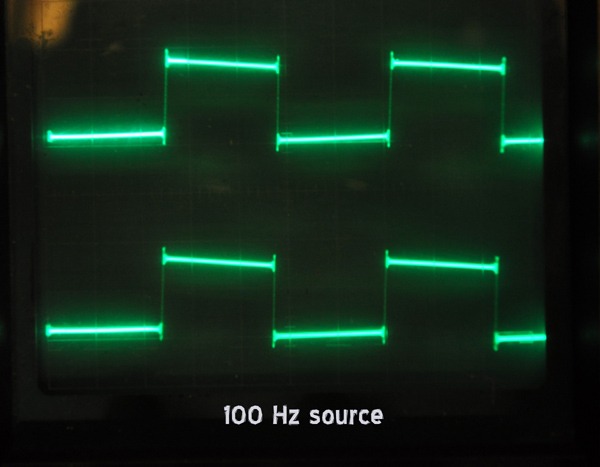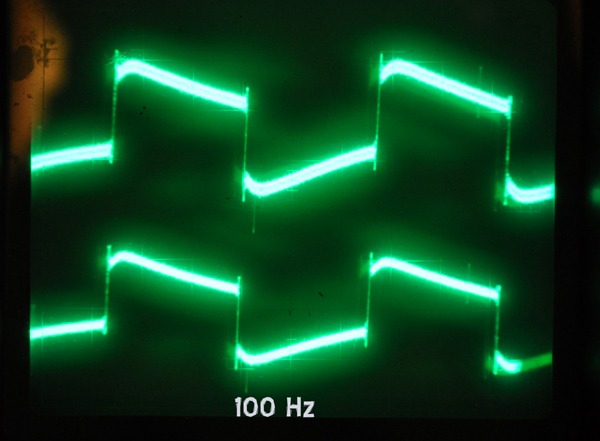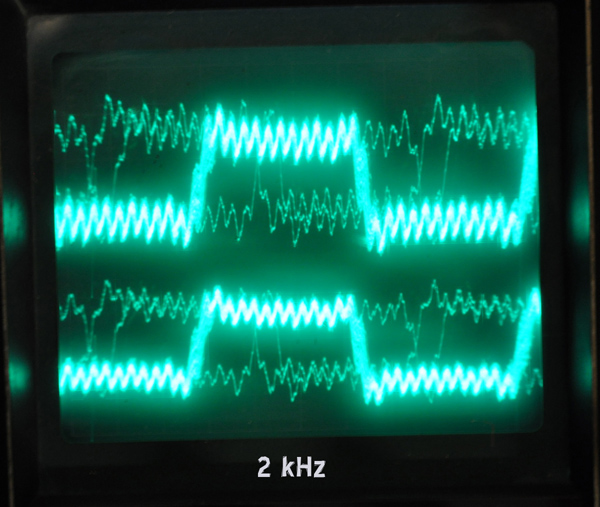So I've finished recapping my garage amp, a Harman Kardon 330A. I probably wouldn't have noticed previously, due to the speakers I was using, but there is an imbalance between the channels, and it seems to be mostly in the bass. I first noticed it visually when I was testing it with some KLH model 5's that I also just overhauled. The woofer excursion on one was about 4 or 5 times that of the other.
I can see that this happens before the power amp, by switching which preamp goes to which power amp. I just got an oscilloscope, so I started poking around with that and I think, not sure, that it's happening in the tone board. I re-cleaned the bass pot, made no difference and it seems really clean on the scope.
Tonight I got a second probe for the scope and looked at both speaker outputs side by side, and confirmed that the difference is greatest in the lower midrange and bass. Then I tried adjusting the bass per channel, since it has split tone controls. Two things were interesting. One, when I adjusted the bass tone control away from center, it seemed to shift the phase of the sine wave I was feeding it. That was a surprise. Secondly, it seemed like a non-linear thing, i.e. I'd set it to equalize the curves at one frequency and it would be different at another. By observing this on the scope while I swept the freq., it was implied to me that the bass control centers on around 400 Hz or so, if that seems right.
Anyway, my question is should I assume it's a problem with the pot, and should I just replace it? Or keep diggin? Or any other ideas??
thanks
-Mark M.
I can see that this happens before the power amp, by switching which preamp goes to which power amp. I just got an oscilloscope, so I started poking around with that and I think, not sure, that it's happening in the tone board. I re-cleaned the bass pot, made no difference and it seems really clean on the scope.
Tonight I got a second probe for the scope and looked at both speaker outputs side by side, and confirmed that the difference is greatest in the lower midrange and bass. Then I tried adjusting the bass per channel, since it has split tone controls. Two things were interesting. One, when I adjusted the bass tone control away from center, it seemed to shift the phase of the sine wave I was feeding it. That was a surprise. Secondly, it seemed like a non-linear thing, i.e. I'd set it to equalize the curves at one frequency and it would be different at another. By observing this on the scope while I swept the freq., it was implied to me that the bass control centers on around 400 Hz or so, if that seems right.
Anyway, my question is should I assume it's a problem with the pot, and should I just replace it? Or keep diggin? Or any other ideas??
thanks
-Mark M.
Tone controls do alter phase shift, that's normal.
Best test (no speakers connected) is a low level squarewave as that will instantly show problems. With the bass and treble centered the squarewave should be unaltered. Any distortion shows a problem.
It should be easy to trace with a scope and working from input to output.
Best test (no speakers connected) is a low level squarewave as that will instantly show problems. With the bass and treble centered the squarewave should be unaltered. Any distortion shows a problem.
It should be easy to trace with a scope and working from input to output.
Just replace all the small electrolytic caps and it will probably work OK, they're all dried out after 40 years now.
Just replaced every electrolytic in the unit🙂Just replace all the small electrolytic caps and it will probably work OK, they're all dried out after 40 years now.
Surprised, I guess that's one good reason folks like to eliminate tone controls...Tone controls do alter phase shift, that's normal.
I'm using a smartphone app for a signal generator, will see how clean the square wave is and if it's decent, I'll try following the signal path. I know it's somewhere between the input jacks and the preamp output. Prime suspect right now is the bass tone pot, although it really doesn't generate any noise when turning it, even on the scope.Best test (no speakers connected) is a low level squarewave as that will instantly show problems. With the bass and treble centered the squarewave should be unaltered. Any distortion shows a problem.
It should be easy to trace with a scope and working from input to output.
The other wildcard is I picked up this old Philips scope for $30. and while it's straightforward enough to figure out, it could be contributing its own distortion as well...
Will update after next excursion, thanks. Oh, last question - is it a given that the channel with lower bass is the one with the problem, or could it equally be that one channel has an overemphasized bass response?
Best test (no speakers connected) is a low level squarewave as that will instantly show problems.
p.s. I'm imagining my workflow would be feeding my signal generator into one trace and then using the other probe to poke around and look for distortion, yes?
I went through it once trying to figure out where the level was dropping but that was a bit too cumbersome for me to do comparatively between channels.
If the bass is lacking compared to mid and hf then a squarewave test will show a problem and it will look like in the picture. As the frequency is lowered the effect is more pronounced.
Which channel is the faulty one 🙂 The one that sounds obviously wrong. If the other had to much bass then the one you are looking at would be "neutral".
You mention the pots... prime suspects tbh. They can get damaged and have a crack in the resistive track.
If you use something like a 100hz squarewave and set the bass and treble to mid point, then the amp should pass the signal untouched.
Once you've confirmed that the signal is reasonable from whatever source you are using, then you just use one trace and follow the signal through the amp.
What about using something like "Audacity" to generate a squarewave? Save it as an MP3 file and burn to CDR.
Which channel is the faulty one 🙂 The one that sounds obviously wrong. If the other had to much bass then the one you are looking at would be "neutral".
You mention the pots... prime suspects tbh. They can get damaged and have a crack in the resistive track.
If you use something like a 100hz squarewave and set the bass and treble to mid point, then the amp should pass the signal untouched.
Once you've confirmed that the signal is reasonable from whatever source you are using, then you just use one trace and follow the signal through the amp.
What about using something like "Audacity" to generate a squarewave? Save it as an MP3 file and burn to CDR.
Which picture?If the bass is lacking compared to mid and hf then a squarewave test will show a problem and it will look like in the picture.
Yeah could do that, will see what the output of my phone app looks like and compare it with audacity. Thanks Mooly.What about using something like "Audacity" to generate a squarewave? Save it as an MP3 file and burn to CDR.
Which picture?
Yeah could do that, will see what the output of my phone app looks like and compare it with audacity. Thanks Mooly.
Well spotted... a prawn sandwich took priority 😀
As you boost and cut the bass you should see something like this happen to the squarewave. Try it on the good channel too. Depending on the type of circuitry it may look more of a "hump" or "saucer shape" as altered but you get the idea.
Attachments
Cool! That's kind of like a circular-saw-tooth waveform🙂 So there will be less of this effect on the good channel yes?
The good channel should produce a true squarewave with the controls centered (no boost or cut).
It should also greatly (and correctly because thats what they do) "distort" the waveform when the controls are moved away from the centre position... as in the pictures.
If you tested with sine waves all you would see is a change in amplitude and no change in the shape of the waveform.
It should also greatly (and correctly because thats what they do) "distort" the waveform when the controls are moved away from the centre position... as in the pictures.
If you tested with sine waves all you would see is a change in amplitude and no change in the shape of the waveform.
GOT it. Can't wait to try it....The good channel should produce a true squarewave with the controls centered (no boost or cut).
It should also greatly (and correctly because thats what they do) "distort" the waveform when the controls are moved away from the centre position... as in the pictures.
If you tested with sine waves all you would see is a change in amplitude and no change in the shape of the waveform.
Looks lousy on both channels, and the signal from the phone is nothing to write home about either, garbage in, 2x garbage out more or less. I'll get some photos going. Distortion on both channels but also on the source... Also had a hard time getting the scope to lock onto the output of the amp. Didn't get started yet tracing through the amp, just had time to look at the speaker outputs (with 8 ohm dummy loads).



An externally hosted image should be here but it was not working when we last tested it.
An externally hosted image should be here but it was not working when we last tested it.
The 100HZ as a source is OK for testing. The amp should pass that unchanged apart from amplitude.
Not quite sure what the two traces are connected to in each of the shots as both look pretty much identical.
Not quite sure what the two traces are connected to in each of the shots as both look pretty much identical.
The 100HZ as a source is OK for testing. The amp should pass that unchanged apart from amplitude.
Not quite sure what the two traces are connected to in each of the shots as both look pretty much identical.
Sorry, those are L & R channels. The phone output is stereo. I tried connecting just one of the rca's and setting the amp to mono so I could look at the exact same signal going through both channels. For some reason that signal was not as clean as if I switched it back to stereo with both rca's plugged in. Anyway, yeah that's just L & R speaker outputs, with 8-Ohm Dale wirewounds. Probably should have both rca's in and switched to mono...
The only comments I would make are that there seems to be a slight amplitude difference between L and R. The top trace "looks" larger in those shots. So you need to make sure that the scope is correctly calibrated first. If both channels of the scope are connected to the same point then the traces should be able to be superimposed over each other with absolutely no difference showing. When you are sure that is OK then check the balance control setting on the amp.
I don't see anything in all those traces that shows a different frequency response in left vs right channels.
I don't see anything in all those traces that shows a different frequency response in left vs right channels.
The only comments I would make are that there seems to be a slight amplitude difference between L and R. The top trace "looks" larger in those shots. So you need to make sure that the scope is correctly calibrated first. If both channels of the scope are connected to the same point then the traces should be able to be superimposed over each other with absolutely no difference showing. When you are sure that is OK then check the balance control setting on the amp.
I don't see anything in all those traces that shows a different frequency response in left vs right channels.
Yeah not sure about the scope, although when I was using just one probe and checking back and forth between ouputs with one probe, I was able to see one channel being slightly higher output than the other. This was just looking at sine waves. I checked across a wide frequency range and noted a greater difference in amplitude at lower frequencies. I'd like to re-do that test as I seemed to get different results doing it a couple of times in a row. So I know that either my setup is sloppy, the amp might have an intermittent or unstable problem, or both.
I'll spend more time calibrating first, don't know what other than to use the inner gain pot on each scope channel to make one the same as the other.
Using the variable gain option on the scope will do as a temporary measure if the internal calibration is out. Absolute accuracy isn't important here, just that both channels respond identically.
If one channel on the amp is higher than the other then it could be down to poor tracking of the volume control and/or balance control rather than a true "gain" issue which is unlikely. The important thing up to now is that I don't see any suggestion of a frequency imbalance between the channels... so far anyway.
If one channel on the amp is higher than the other then it could be down to poor tracking of the volume control and/or balance control rather than a true "gain" issue which is unlikely. The important thing up to now is that I don't see any suggestion of a frequency imbalance between the channels... so far anyway.
So far the biggest suggestion of a frequency imblance is in what comes out the speakers🙂 You can see 5x greater woofer excursion on one side, and if you shift the balance all the way to one side or the other, one side sounds like its missing bass. Not completely, i.e. the woofer is getting some signal. Flipping which preamp goes to which power amp flips which speaker has greater bass output.
I'll spend more time with it tonight and try to get some better documentation and confirmation. Thanks very much Mooly.
I'll spend more time with it tonight and try to get some better documentation and confirmation. Thanks very much Mooly.
- Status
- Not open for further replies.
- Home
- Amplifiers
- Solid State
- HK 330A channel imbalance

